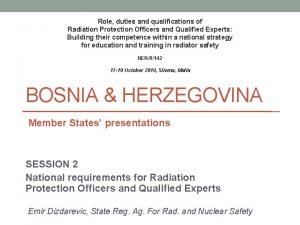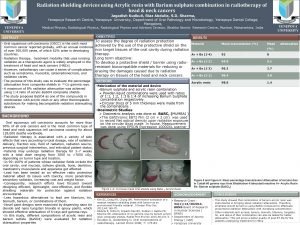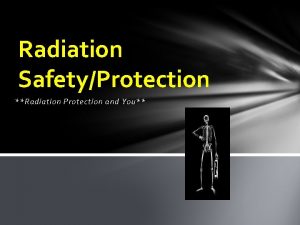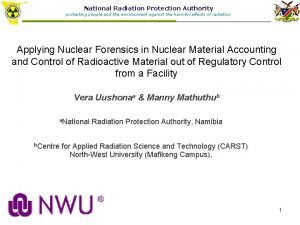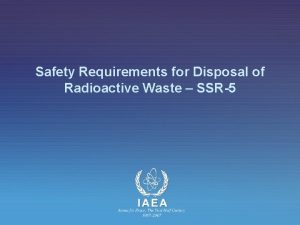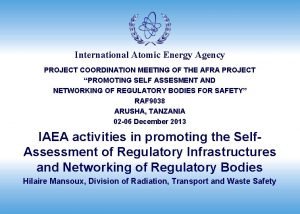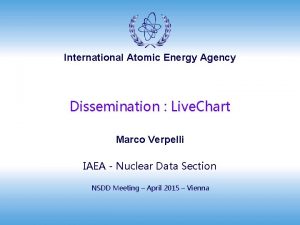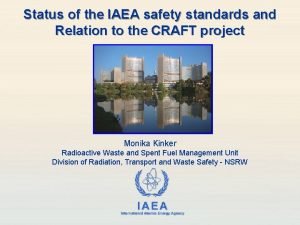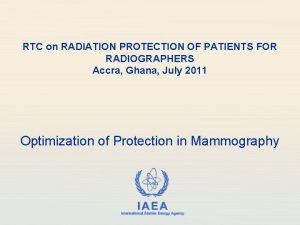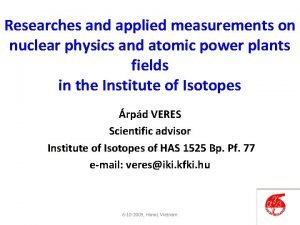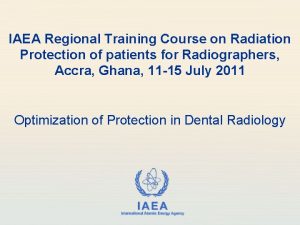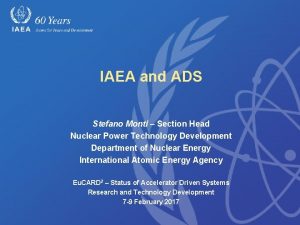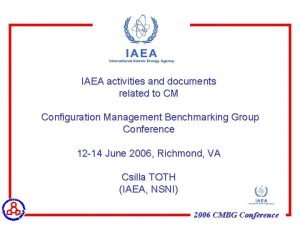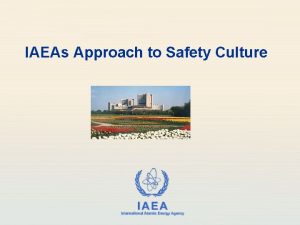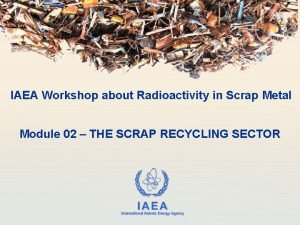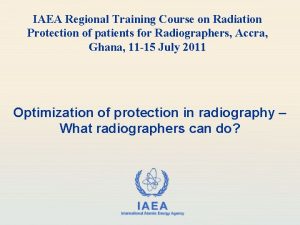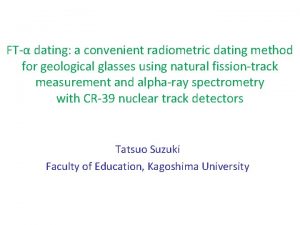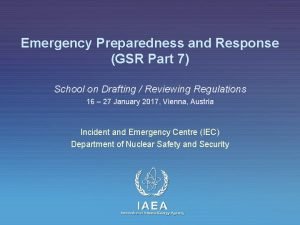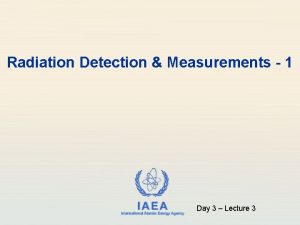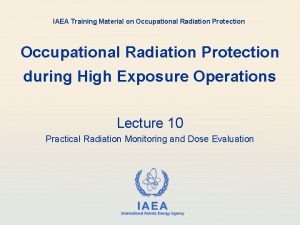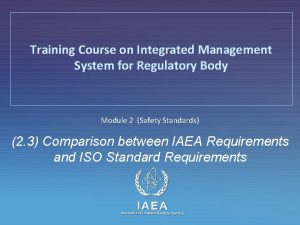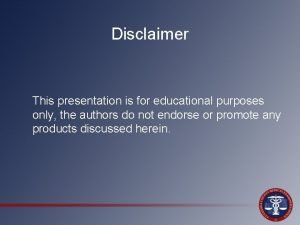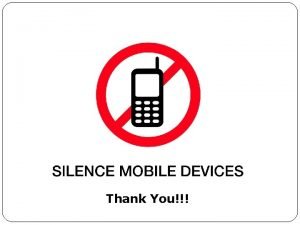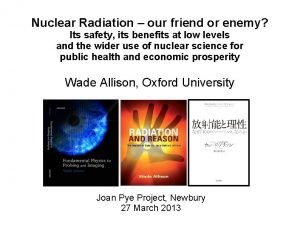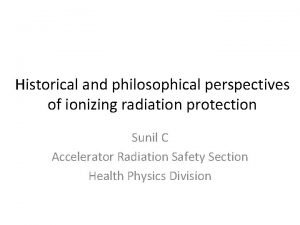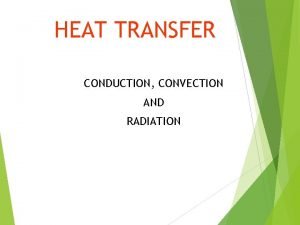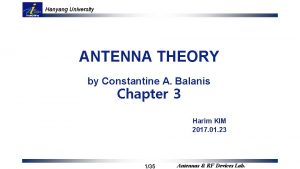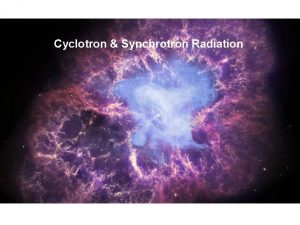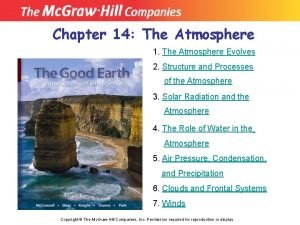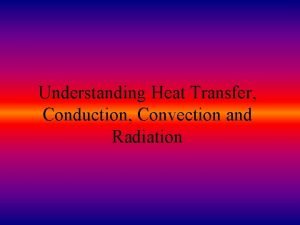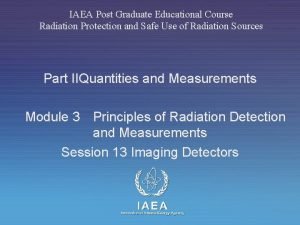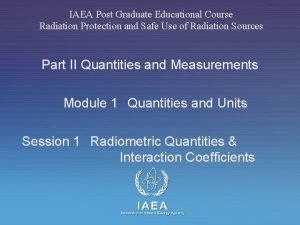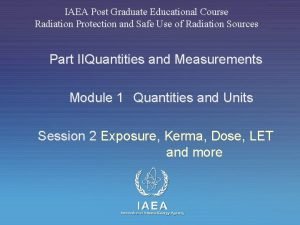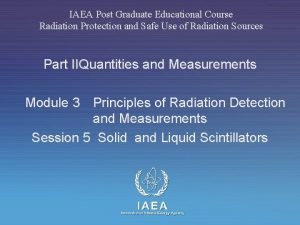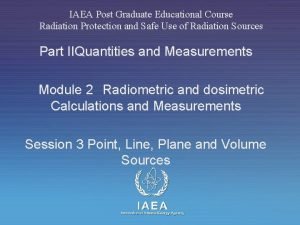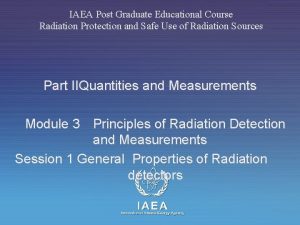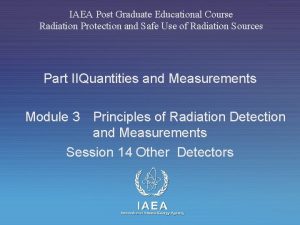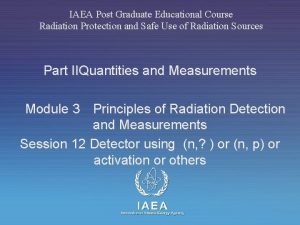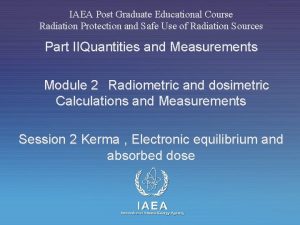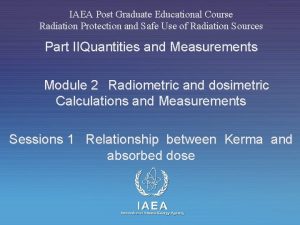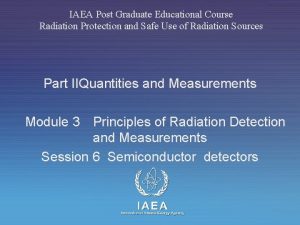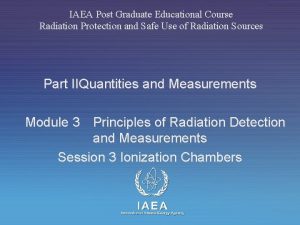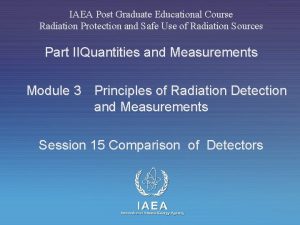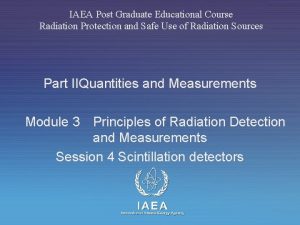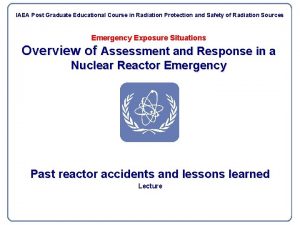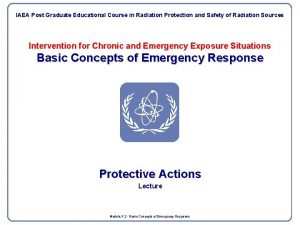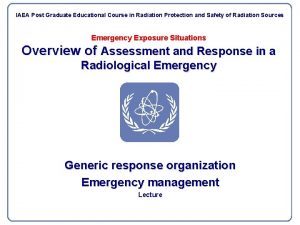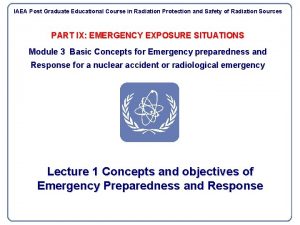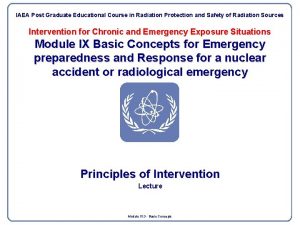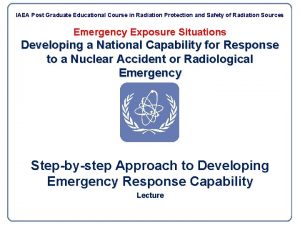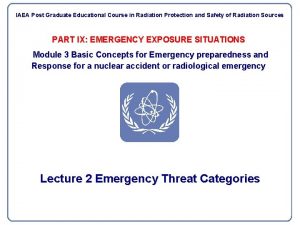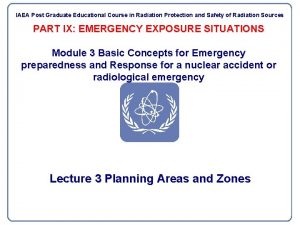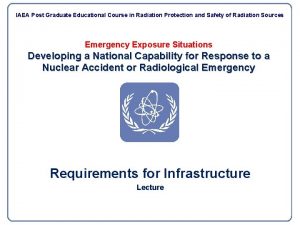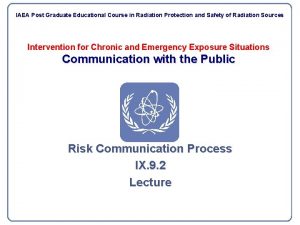IAEA Post Graduate Educational Course Radiation Protection and








































- Slides: 40

IAEA Post Graduate Educational Course Radiation Protection and Safe Use of Radiation Sources Part II Quantities and Measurements Module 3 Principles of Radiation Detection and Measurements Session 11 : Neutron detectors IAEA International Atomic Energy Agency

Overview Students will learn about : • sources of neutrons and properties of neutrons • Processes for neutron detection • Neutron detectors • Survey meter for neutron detection • IAEA 2

Where do you find neutrons? • Nuclear Reactors • Isotopic Neutron Sources Ra - Be, Am - Be, Pu - Be 252 Cf • Particle Accelerators (p, n) (a, n) T(d, n)He IAEA 3

Properties of Neutrons • • • Mass ~ Mass of Proton Charge = zero Half life = 10. 6 minutes Energy Range 0. 001 e. V → 20 Me. V Cross Sections or probability of interaction IAEA 4

Thermal Neutron Energy En < 1 e. V Epithermal 1 e. V < En < 10 ke. V Fast En > 10 ke. V IAEA Cross Section Barns (10 -24 cm 2 ) σa ~ 1/v Small with resonances Small (few barns) 5

Neutron Absorption Cross Section for 197 Au IAEA 6

Cross Section for 198 Au IAEA 7

Neutron Detectors • Radiation detectors require ionizing radiation that interact with atomic electrons and either ionize or excite atoms • Neutrons do not interact with electrons, only nuclei • Therefore must use nuclear reaction in a detector to detect neutrons IAEA 8

Ionization and Excitation • To produce ionization or the excitation of atoms requires energy • The energy of neutrons vary from 10 -3 to 107 e. V (10 decades of energy) • Neutrons with energies less than 1 ke. V can not supply the energy required to be detected by a radiation detector • Therefore, low energy neutrons must use nuclear reactions to supply the energy required for detection IAEA 9

Nuclear Interactions needed • To detect neutrons, nuclear reactions must be incorporated into nuclear detectors • For low energy neutrons, the reactions must also supply the energy required for the ionizing and/or excitation processes • Neutrons are always accompanied by a large background of gamma rays IAEA 10

Neutron Scattering • If the neutron has sufficient energy, En > 1 ke. V, it can transfer enough energy to a nucleus to cause the nucleus to become a heavy, charged particle. • Reaction works best with hydrogen where the scattering nucleus is a proton. In this case Ep = En cos 2 J where J is the neutron scattering angle. If the scattering angle is 180 o , then Ep = En. • Cross section or probability for scattering interaction is approximately constant over a wide range of energies for hydrogen. IAEA 11

Example: Hydrogen Filled Proportional Detector g n p H 2 fill gas IAEA Insulator e current or pulses out 12

Example: Plastic or Liquid Scintillation Detector n p Photomultiplier Tube Plastic or Liquid Scintillator IAEA 13

Neutron -- Charged Particle Reactions • The following four reactions are all exoergic -They produce energy and charged particles and can be used to detect low energy neutrons • The have very large cross sections for low energy neutrons 6 Li + 1 n 3 He + 1 n 10 B + 1 n + 4 a + 4. 78 Me. V 3 H 3 H + 1 p + 0. 764 Me. V 7 Li* 14 N IAEA + 1 n 14 C + 4 a + 2. 792 Me. V + 4 a + 2. 310 Me. V + p + 0. 626 Me. V 14

Neutron -- Charged Particle Reactions • Each of these reactions can be incorporated into one of the existing radiation detectors to detect thermal or low energy neutrons. IAEA 15

Example : 3 He filled Proportional Detector 3 He + 1 n 3 H + 1 p + 764 ke. V g n 3 T p Insulator e IAEA current or pulses out 16

Number of counts per channel Pulse Height Energy Deposited in Detector IAEA 17

Example : Ionization or Proportional Detector lined with Boron 10 B + 1 n 7 Li* n g + 4 a + 2. 792 Me. V + 4 a + 2. 310 Me. V n Boron Insulator 7 Li e IAEA a current or pulses out 18

Ionization or Proportional Detector Filled with BF 3 Gas n n g 7 Li 7 Li a a IAEA e Insulator current or pulses out 19

Number of counts per channel Pulse Height Energy Deposited in Detector IAEA 20

Compensated Ion Chamber n γ + voltage + e - + e 0 voltage Current out - voltage Current out = i+n + i+γ + i-γ γ IAEA = i +n 21

Model RC 6 EB Compensated Ion Chamber R. P. Henderson, RC 6 and RC 7 Ionization Chambers, AECL- 805 IAEA 22

3 H + 4 a + 4. 78 Me. V Example: 6 Li + 1 n Li. I(Tl) Scintillation Detector n a 3 T IAEA Photomultiplier Tube Li. I(Tl) Scintillator 23

Neutron Capture Reactions • Neutron capture results in the release of between 5 and 10 Me. V of energy as prompt gamma rays • Prompt gamma rays can be detected by film • Material such as a cadmium compound can be added to scintillators and the prompt gamma rays from the capture process detected IAEA 24

Neutron Capture Reactions The product nucleus may be radioactive and the residual activity can be detected, for example: 59 Co + n → 60 Co → 60 Ni + β- + 2 γ’s 197 Au + n→ 198 Au → 198 Hg + β- + γ The use of neutron activation is a two step process 1) The neutron capture leading to a radioactive nucleus 2) The detection of the resulting activity. IAEA 25

Self-Powered Detectors The process can also be incorporated into a detector such as the “self-powered” neutron detector used for flux mapping in reactors. However, because of the time delay between the neutron capture and the appearance of the decay radiation, these detectors cannot be used in the control of reactors, but are useful for making flux maps of the core. IAEA 26

Self-Powered Detectors n γ βˉ Collector M Insulator Emitter βˉ βˉ n IAEA 27

Common Emitter Materials Rhodium 103 Rh (n, g) 104 Rh 2. 44 Me. V b- 104 Pd 44 sec Sensitivity 1 E-21 A / (n/cm 2 - s) Vanadium 51 V (n, g) 52 V 2. 47 Me. V b 3. 8 min 52 Cr Sensitivity 5 E-23 A / (n/cm 2 - s) IAEA 28

Neutron Activation Foils • More commonly, the neutron activation process is used with foils • Foils have three main advantages • Two step process -- the foils are placed in a neutron flux and activated and then removed to a low background laboratory for counting -- Insensitive to the gamma rays that are always present with neutrons • Foils can be very small and do not perturb the neutron flux that is being measured • By selecting foil materials with different neutron cross sections neutrons in different energy ranges, the neutron spectra can be determined • For a material to be useful for the foil activation technique, it must have a useable half life and produce an easily measured and identifiable radiation IAEA 29

Survey Instruments for the Detection of Neutrons • Neutrons have wide energy range of neutron energies and the relatively small cross sections for epithermal and high energy neutrons. The usual procedure in detecting neutrons is to thermalize them and then use a thermal neutron detector. • the usual procedure in detecting neutrons is to thermalize them and then use a thermal neutron detector • Hydrogenous materials such as paraffin or polyethylene are usually used to moderate the neutrons. • By using different thicknesses of moderator, some information can be gained about the energy distribution of the neutrons. IAEA 30

Bonner Ball Neutron Detector -- from book “Principles of IAEA Nuclear Radiation Detection” by Eichholz and Poston 31

Bonner Ball Detection System Ludlum Model 42 -5 Six spheres ranging in size from 2” (5. 1 cm) to 12” (30. 5 cm) IAEA 32

Neutron Spectrometry with Bonner Spheres IAEA

Relative Detection Efficiencies of Bonner Spheres T. L. Johnson, Y Lee, K. A. Lowry, and S. C. Gorbics, Proceeding of the American Nuclear Society Topical Meeting on Theory and Practices in Radiation Protection IAEA and Shielding, April 1987. 34

Polyethylene Boron Plastic with holes BF 3 Detector Polyethylene Neutron REM Counter IAEA 35

Canberra Neutron Meter IAEA 36

Spherical neutron dosimeter based on a 3 He neutron detector J. W. Leake, Nucl. Instrum. Meth. 63, 329 (1968) IAEA 37

IAEA Canberra Cramal 31 Neutron Dosimeter 38

IAEA Ludlum Neutron Dosimeter 39

Summary • Nuclear reactions can be incorporated into • • • radiation detectors to detect neutrons Nuclear reactions may have to supply the energy required for the radiation detectors Neutron fluxes are always accompanied by gamma rays Difficult to determine the energy of neutron Discriminating circuits can be used to separate neutrons from gamma radiation. d IAEA 40
 Radiation protection officer qualifications
Radiation protection officer qualifications Barium sulphate board for radiation protection
Barium sulphate board for radiation protection Cardinal principles of radiation protection
Cardinal principles of radiation protection National radiation protection authority namibia
National radiation protection authority namibia Ssr-5
Ssr-5 Saris iaea
Saris iaea Livechart iaea
Livechart iaea Iaea pcmf
Iaea pcmf Iaea gsr part 4
Iaea gsr part 4 Rtc protection film
Rtc protection film Nuclear wastes
Nuclear wastes Iaea
Iaea Stefano monti iaea
Stefano monti iaea Iaea
Iaea Iaea
Iaea Steel scrap
Steel scrap Iaea
Iaea Iaea
Iaea Gsr part7
Gsr part7 Pcmf iaea
Pcmf iaea Film badge dosimeter
Film badge dosimeter Iaea
Iaea Iaea gsr part 2
Iaea gsr part 2 Disclaimer educational purposes only
Disclaimer educational purposes only Course number and title
Course number and title Post merger integration presentation
Post merger integration presentation One and a half brick wall
One and a half brick wall Course interne moyenne externe
Course interne moyenne externe Office of graduate and professional studies
Office of graduate and professional studies What are the nature of educational psychology
What are the nature of educational psychology How is thermal energy transferred?
How is thermal energy transferred? Greenhouse effect long and shortwave radiation
Greenhouse effect long and shortwave radiation Solid liquid and gas diagram
Solid liquid and gas diagram For parents and friends radiation threat
For parents and friends radiation threat Ionizing radiation examples
Ionizing radiation examples What is heat transfer conduction convection and radiation
What is heat transfer conduction convection and radiation Radiation heat transfer examples
Radiation heat transfer examples Duality theorem in antenna
Duality theorem in antenna Cyclotron and synchrotron radiation
Cyclotron and synchrotron radiation Venn diagram of conduction, convection and radiation
Venn diagram of conduction, convection and radiation Which is the best surface for reflecting heat radiation?
Which is the best surface for reflecting heat radiation?
